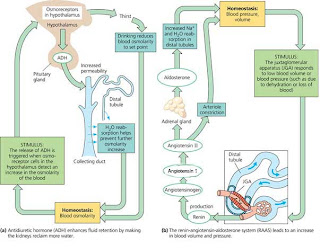SUMMARY
The sand used for the building purpose contains a lot of impurities like stones, shells ,mud particles and decayed particles of living things. The workers commonly use sieves as the apparatus for the removal of these waste materials ,like wise the living organism also produces waste material (nitrogenous substances, ions ,CO2 and water) as a by-product of various metabolic activities in the cell. Living organism also have an apparatus like sieve called excretory organ. They are responsible for the process of excretion or elimination of waste materials in the body.
Here we are mainly focused on the mechanism of elimination of nitrogenous waste materials. The nitrogenous waste materials will be varies from organism to organism based on their habitat( where they located).Ammonia ,urea and uric acid are the different types of nitrogenous waste materials. Those organism which excretes
a) Ammonia as the waste materials are called ammonotelic organism.eg:-Many bony fishes, Aq.amphibians and Aq. Insects.Ammonia is highly toxic in nature and their elimination require a large amount of water so most of the ammonotelic organism are seen in water.
b) Urea as the waste materials are called ureotelic organism.eg:- Mammals,many terrestrial amphibians and marine fishes.urea is less toxic than ammonia and it require a less amount of water for their elimination .
c) Uric acid as the waste materials are called uricotelic organism.eg:- Reptiles,birds ,landsnails and insects.
The excretory system in human being consist of a pair of kidney,a pair of ureters,a urinary bladder and a urethra. Each kidney has a millions of tubular structures called NEPHRONS.It is the basic unit of a kidney and has two portion.ie Glomerulus and renal tubule.Glomerulus is a group of fine capillaries formed from afferent arterioles .The renal tubule consist of double walled cup-like structure called Bowman’s capsule,proximal convoluted tubule(PCT),loop of Henle and distal convoluted tubule(DCT).The DCT of many nephrons joints to a common duct called collecting duct that ultimately open in to a renal pelvis through medullary pyramids.
Urine formation involves 3-process.ie,1) Glomerular filtration 2) Tubular reabsoreption 3)Tubular secretion.
The filtration is done by glomerulus due to high glomerular capillary blood preasure.about 1200ml of blood is filtered by the glomerulus per minute and forms 125ml of filtrate per minute in the bowman’s capsule, this is called glomerular filtration rate(GFR).JGA plays a significant role in the regulation of the GFR.PCT is the major site of re-absorption and selective secretion.DCT and collecting duct allows extensive re-absorption of water and certain electrolytes which helps in osmoregulation : H +K+ and NH3 could be secreted in to the filtrate by the tubule to maintain the ionic balance and pH of body fluid.
A counter current mechanism operates between the 2-limbs of the loop of Henle and vasa recta.The filtrate gets concentrated as it moves down the descending limb but is diluted by the ascending limb .Finally the urine is collected in the urinary bladder till a voluntary signal from CNS carries out its release through urethra. Skin ,lungs and liver.






